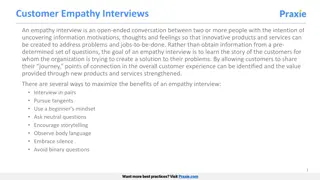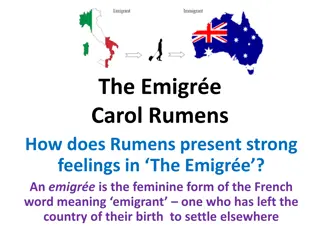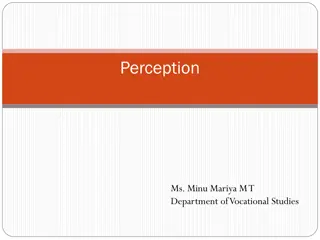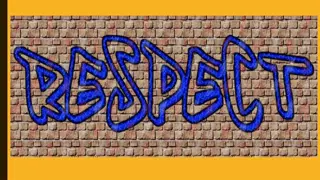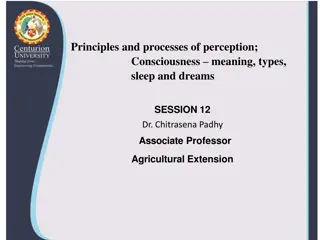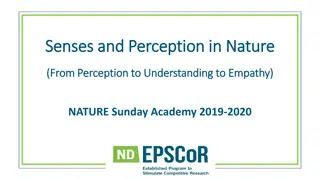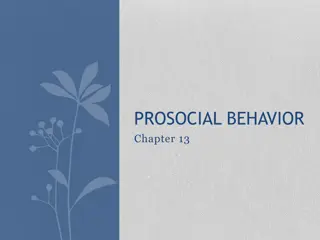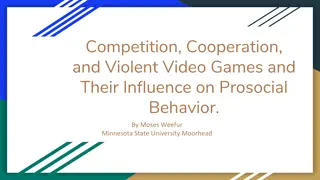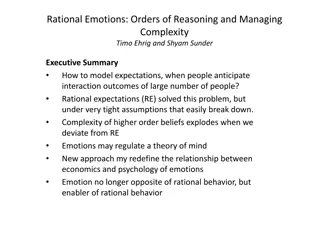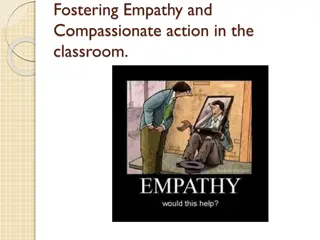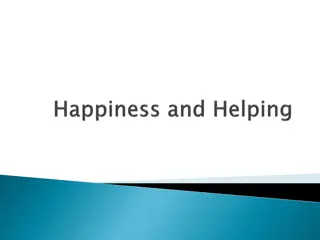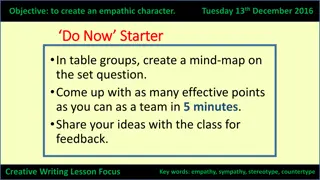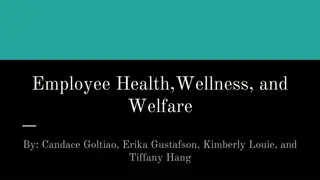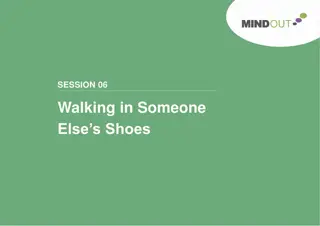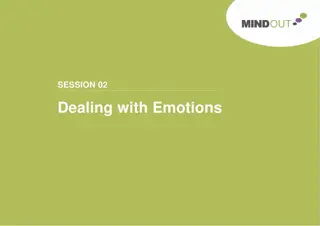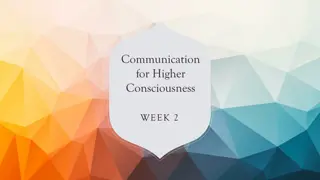Understanding Empathy and Prosocial Behavior in Emotions and Perception Class
This content delves into the concepts of empathy, emotional regulation, and the ethics of empathy in relation to prosocial behavior. It explores how empathy involves emotional response and perspective taking, the challenges of balancing emotions and mental calculation, and the ethical dilemmas surrounding empathy in healthcare decisions. The content emphasizes the importance of understanding emotions and perspectives to foster altruistic actions and ethical decision-making.
Download Presentation

Please find below an Image/Link to download the presentation.
The content on the website is provided AS IS for your information and personal use only. It may not be sold, licensed, or shared on other websites without obtaining consent from the author. Download presentation by click this link. If you encounter any issues during the download, it is possible that the publisher has removed the file from their server.
E N D
Presentation Transcript
Emotions and Perception Class 18 (Diary 4)
Review Question 1 Prosocial behavior can be motivated by: ___A. Empathy ___B. Desire to look good to others ___C. Desire to look good to oneself ___D. Personal relief from others disturbing distress ___E. All the above X 2
Review Question 2 The main point of Batson s Elayne Gets Shocked study was that altruism (selfless helping) can occur if: ___A. Helpers are very smart people ___B. Helpers are not in a hurry ___C. Helpers feel empathy ___D. Helpers want to feel heroic ___E. Helpers want to get a free cookie X 3
Empathy = Emotion Match + Perspective Taking Not simply reacting to another s emotions Empathy Emotional Contagion Not simply recognizing another s distress Empathy Personal Distress Requires: 1. Emotions aroused by another 2. Matching between own/other s feelings 3. Making sense of this match Empathy = Emotional Response + Perspective Taking Perspective Taking means not only feeling what the other is feeling but also seeing the situation as he/she does. 4
Emotional Challenge of Empathy We use our own emotions to understand the other s emotions. Affect as Information (Schwarz & Clore, 1996). But need proper distance from emotions to use them. Empathy = Balancing emotional openness with mental calculation. Requires feeling and thinking, in balance. Too emotional overwhelmed Too analytical detached 5
Empathy and Emotional Regulation Decety, 2010 Emotional Understand Arousal Emotional Response to Other Limbic System ACC Insula Emotional + + Own Emotion is Regulation / Response to Other Mental Control + Perspective Taking Helpful Action Theory of Mind + + + Prefrontal Cortex TPJ LIMBIC SYSTEM INSULA TPJ PREFRONTAL CORTEX 6 ACC
The Ethics of Empathy Paul Bloom, 2017 Sheri Summers is 9 years old. She had a fatal and painful disease. There is a treatment, but it requires being on a waiting list. Patient Perspective: Take a minute and think about being Sheri; Being scared, in pain, seeing the fear in your parents eyes. Wondering what will happen to you. OR MD Perspective: Take a minute and think about being the chief of medicine, wanting to do the right thing for all your patients. Patient Perspective: YES MD Perspective: NO Should Sheri go to the top of the list for treatment? 7
Can Empathy Be a Bad Thing? Paul Bloom, 2017 versus Single Sufferer Natalee Holloway 10000s Suffering in Darfur versus Cute Panda Essential Plankton 8
How Empathy for Victims Leads to Sadism to Victimizers Bad Guy torments innocent nice people. We empathize with victims. Our empathy makes us dislike the bad guy. Good Guy shows up. He seeks to punish bad guy We want bad guy punished. Go for it, Good Guy! Make our day! We feel good when bad thing happens to Bad Guy Bottom line: More empathy for victims less empathy for victimizer. Makes it OK to enjoy another person s (Bad Guy s) suffering. 9
OUTLINE OF TODAYS CLASS I. How stress and anxiety affect perception II. How Resources improve perception A. What are resources B. The Resources and Perception Model C. Experiments showing how resources affect perception 10
Emotions and Perception: The New Look New Look research: Late 1940s early 1960s Basic Idea: Your emotions, needs, goals affect how you literally perceive things: How you see, hear, feel, taste things. They Saw a Game Hastorf & Cantrel,1954. Albert Hastorf 1921-2011 Princeton vs. Dartmouth football game. One of the nastiest on record. Princeton fans: Dartmouth team committed way more penalties, refs were blind Dartmouth fans: Princeton team committed way more penalties, refs were blind 11
Emotions and Perception: The New Look Value and need---in perception: Bruner & Postman, 1947 What kids actually hold in their hands Rich kid s judgments of object s size. Rich kid Poor kid s judgments of object s size. Poor kid 12
Fear and Perception of Height and Distance Stefanucci, Gagnon, Tompkins, & Bullock, 2012 Study 1 Subjects imagine falling from height onto: a. Control: An empty pool b. Threat: A pool containing a bed of nails Control subjects stood above empty pool Threat subjects stood above nail-filled pool TASK: How high up are you? Study 2 Subjects imagine jump and land in: a. Control: An empty pool or b. Threat: A pool containing a bed of nails Control subjects stood before empty pool Threat subjects stood before nail-filled pool TASK: How far is distance across pool? 13
e i m a t t O v e r e s A m o u n t 14
Resources and Perception Model Challenging things negative arousal amplified percept. Psychological resources reduce negative arousal. Resources should moderate perception of challenging things. Boosted resources less amplified perception Depleted resources more amplified perception 15
Psychosocial Resources Social Support Self Worth, Self Esteem Self-Efficacy Emotional Disclosure 16
Resources and Coping Reduced depression and anxiety Reduced cardiovascular response to stress Reduced levels of norepinephrine, epinephrine, cortisol Better immune functioning Fewer colds, fewer heart attacks, quicker recovery post-MI, reduced cancer, easier childbirth, etc. 17
Emotional Support and Mortality After Heart Attack (Berkman et al., 1992) 40% Mortality Rate 30% 20% 10% 0% Emotional Support Absent Emotional Support Present 18
Resources and Perception Theory If stress amplifies perception And if resources reduce stress Then more resources more accurate perception. 19
Resources and Perception Program Resources will moderate: Social Perception others distress Visual Perception steepness, distance, height 20
Social Perception and Cry Ratings Harber, Einav, & Lang, (2008). European J. Social Psych, 38, 296-314. Social contact manipulation: Guided imagery task Friend: Image the best person in your life (to boost support) Neutral Person: Image a neutral person you know (support is unchanged) Betrayer: Image someone who betrayed you (to weaken support) Listen to and Rate 8 baby cries. How distressed is the baby based on this cry? 1 2 3 4 5 6 7 A Great Degree Not at All 21
Social Context and Emotional Disclosure on Baby Cry Ratings 4.6 4.4 Cry Ratings 4.2 Suppress Disclose 4 3.8 3.6 Friend Neutral Person Betrayer Subjects who thought about a friend heard the cries as least distressed Subjects who thought about a betrayer heard the cries as most distressed. Emotional Disclosure What happens if subjects who could disclose their thoughts and feelings? 22
Social Context and Emotional Disclosure on Baby Cry Ratings 4.6 4.4 Cry Ratings 4.2 Suppress Disclose 4 3.8 3.6 Friend Neutral Betrayer For Betrayer subjects who could disclose feelings of being betrayed, baby cries are no longer amplified. Disclosure boosted resources, counteracted the bad effects of recalling a betrayer, and thereby judgments of the baby became less extreme. 23
Psychosocial Resources and Physical Perception Do resource affect our visual perception? Do we literally see things differently under ample vs. depleted resources? Do resources affect accuracy of perception? Baby cry studies do not address accuracy. Do resources other than social support affect perception? 24
Social Support and Slant Perception Schnall, Harber, Stefanucci, & Proffitt (2008). Journal of Experimental Social Psychology, 44, 1246-1255 Conscious slant perception of hills is exaggerated (5% is seen as 20%, etc.). Slant distortion is lessened under lower physical load -- Light back pack vs. heavy back pack -- Physically refreshed vs. fatigued -- Good physical cond. vs. poor cond. -- Younger vs. older Is slant distortion reduced under lower psychological load? 25
Study 1: Do hills appear different when alone vs. with a friend? Participants Passersby at campus walk Alone (n = 14) Same-sex friend pairs (n = 17; both participate) All wear heavy backpack, face steep hill Hand protractor Measures Verbal: How steep is this hill, in degrees? Visual Judgment: hand protractor Haptic: palm board Palm board 26
Social Support and Slant 70 60 50 40 Alone With Friend 30 20 10 0 Note: Line shows actual slant Verbal Visual Haptic Being with a friend leads to less exaggerated, more accurate hill-slant perception Verbal measure: How many degrees is the hill slant? Visual measure: The protractor-device subjects used to show how steep the hill looked. No difference on Haptic measure: The palm board capturing how their body saw the hill. 27
Effects of Friendship Duration and Mood on Slant Perception Friendship Duration (in months) Mood (negative) Verbal r = -.49, p < .05 Visual r = -.50, p < .05 Haptic r = -.14, p = ns Verbal r = -.01, p = ns Visual r = -.13, p = ns Haptic r = .01, p = ns Friendship duration mattered: The longer you knew your friend, the less steep the hill appeared. Mood did not matter: Being in a worse or better mood had no effect on hill slant perception. 28
Study 1 Alternative Explanations Instrumental Support Social Desirability Social Facilitation Sampling Bias Study 2 fixes these problems: Just think about a good friend, a neutral person, a bad person . n = 36, 49% female Imaged other: Think about Positive, Neutral, or Negative Person Random Assignment 29
Slant Study 2: Imaged Support and Slant Perception 70 60 50 Positive Neutral Negative Degrees 40 30 20 Note: Line shows actual slant 10 Verbal Visual Haptic Measure Results mirror Study 1: People who recall a friend see hill as less steep, and more accurately, than those who thought about a neutral person or a nasty person. Can t be due to wanting to impress friend, or hoping to be rescued by friend, or being aroused by friend because NO FRIEND IS ACTUALLY THERE! 30
Correlations Between Relationship Quality and Slant Perception Verbal Visual Haptic Measure Measure Measure Close -.37* -.36* .10 Warm -.33* -.28 .22 Happy -.39* -.20 .12 Friendship closeness mattered: The closer you felt toward the person you thought about, the less steep the hill appeared. Mood did not matter: Being in a worse or better mood had no effect on hill slant perception. 31
Resources and Distance Perception Harber, Iacovelli, & Yeung, 2012 (Study 1) Will psychosocial resources affect distance perception? Will self-worth serve as resource? 32
Self Worth Induction Boosted: Imagine best success Unchanged: Imagine doing laundry Depleted: Imagine worst failure N = 107, 63% female 33
Distance Estimation Task 1. 2. Subjects put face in chin rest; room lights go off and table lights go on. Turned the handle on fishing reel to pull clear plastic car (at far end of track) to their face. Reported how far the car was from them a the yellow, green, and pink tabs. 3. 34
Target Objects Low Threat High Threat Plasticcar contains cute cat toy. Plastic car contain a live tarantula 35
Resources and Distance Perception Study Design Positive Self- Worth Neutral Self- Worth Negative Self- Worth Cat Toy No Diff No Diff No Diff Tarantula Accurate (Correct Distance) Average Inaccurate (Overly Close) (A Bit Too Close) 36
Distance Accuracy as for Low Threat (Cat Toy) Subjects, Due to Positive, Neutral, Negative Self-Image 8 7 Exaggerated Closeness 6 5 Tarantula Cat Toy 4 3 2 1 0 Positive Neutral Negative This graph shows that self-image conditions did not differ for subjects in the cat toy (low threat) condition. Note that a score of 0 means perfect accuracy, no exaggerated closeness. A score of 6 (for example) means the car was seen 6 inches closer than it was. 37
Distance Accuracy as for High Threat (Tarantula) Subjects, Due to Positive, Neutral, Negative Self-Image 8 7 Exaggerated Closeness 6 5 Tarantula Cat Toy 4 3 2 1 0 Positive Neutral Negative This graph shows that self-image conditions did affect subjects in the tarantula high threat) condition. Tarantula subjects who affirmed their selves were super accurate even more accurate than the Cat toy Subjects. But Tarantula subjects who dis-affirmed their selves exaggerated closeness to the tarantula. Recall that 0 means no difference between perceived distance and actual distance. 38
Evidence of Self-Worth Moderation Neutral Object Distance Tarantula Distance Felt good about self r (55) = -.27 * r (48) = -.01 Felt bad about self r (55) = +.31 * r (48) = .13 Subjects who felt better about themselves saw the tarantula as further away (and more accurately). Subjects who felt worse about themselves saw the tarantula a closer (and less accurately). Feeling good or bad about oneself had no effect on perceptions of the neutral cat toy. 39
Self Esteem, External Support, and Height Judgments Harber, Iacovelli, & Yeung, 2012 (Study 2) PHOTO LOOKING DOWN STAIRWELL N = XXX, XX% female, age = XX.XX 40
Do resources moderate height judgments? Does trait self esteem operate as a resource? Do internal resources supplement external resources? Note that this subject has a physical resource she can draw upon: The handrail which gives her a feeling of security. What if she didn t have this physical resource? HANDRAIL 41
Heres what it looked like for subjects in the no physical resource condition. They had to look down without being able to hold the handrail. 42
Self Esteem, External Support, and Height Perception 140 120 100 Height in Feet 80 High Esteem Low Esteem 60 40 Actual height 20 0 Hands on Rail Hands Taped This graph shows that for subjects with the resource of high self-esteem, holding or not holding the handrail made little difference. Both groups were equally, and quite, accurate in their height perceptions. 43
Self Esteem, External Support, and Height Perception 140 120 100 Height in Feet 80 High Esteem Low Esteem 60 40 20 0 Hands on Rail Hands Taped This graph shows that the handrail mattered much more for low esteem subjects. Low esteem subjects who COULD hold the handrail did fine. Perception was very accurate. BUT, low esteem subjects who COULD NOT hold the handrail were very inaccurate. 44
Conclusions Resources affect the perception of : Others distress (baby cries) Distance to stressors (tarantulas) Heights Hill slants Similar effects derive from different resources: Social support (baby cries, hill slant) (baby cries) (distance to tarantula) (height) Emotional disclosure Self worth Self esteem Resources may enhance coping by moderating stressor perception 45



